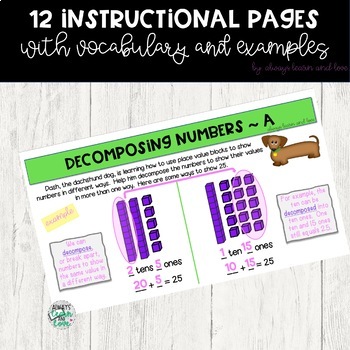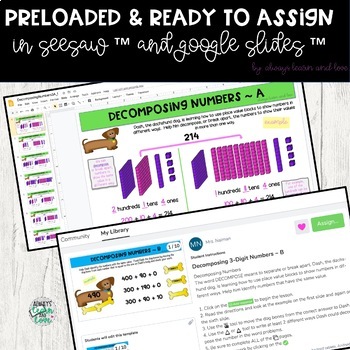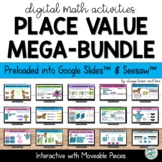Decomposing 2 and 3 Digit Numbers Place Value to 100 and 1000 Digital Bundle
- Zip
- Google Apps™
- Internet Activities

Products in this Bundle (2)
Also included in
- This collection of numbers to 100 and numbers to 1000 digital math activities is pre-loaded and ready to use with Seesaw™ and Google Slides™ for 1st grade and 2nd grade students for number sense skills ideal for Distance Learning and Homeschool. Students learn and practice 2-digit and 3-digit numbPrice $65.79Original Price $85.26Save $19.47
Description
Pre-loaded and ready to use with Seesaw™ and Google Slides™, 2nd grade students develop the conceptual understanding for 2-digit and 3-digit subtraction with digital activities ideal for Distance Learning and Homeschool. The activities focus on numbers to 100 and numbers to 1000 and are differentiated with digital manipulatives. Students practice different names for numbers including decomposing numbers, or breaking them apart, to build the foundation for subtraction addressing numbers in base ten standards.
If you provide distance learning as a teacher or parent, integrate digital learning in your classroom, or homeschool, these interactive Seesaw™, Google Classroom™, PowerPoint, and PDF activities are perfect for you. They would work well for independent work, home learning, non-traditional instruction, intervention, and RTI. Each of the activities comes in all 4 formats listed below and can easily be uploaded to Microsoft, Nearpod, and other online platforms.
Information:
Seesaw™: These activities are preloaded into Seesaw and, by clicking on a link provided, will automatically download to your Seesaw Activity Library with all of the icons, shortcuts, and directions included. There is no need to create anything as these activities are ready to assign to students. All directions are included.
Google Classroom™: Download these files directly into your Google Classroom or Slides account and assign to students by clicking on a link provided. There is no need to create anything as these activities are ready to assign to students. All directions are included.
PowerPoint and PDF: There are 4 files for you to open, use, and easily upload to Microsoft or Nearpod.
About the Activities
Each of the 6 activities comes with at least 1 instructional slide (including key vocabulary terms) and an example slide so students know exactly what to do, and they contain 8-10 practice slides each for students to complete using engaging and interactive styles such as moveable parts, digital manipulatives, and self-correcting pieces for a total of 60 slides.
1. Decomposing Numbers A (in two formats-2 digit numbers and 3 digit numbers) : Students are introduced to the vocabulary term of decompose and are show how to break apart a ten to make ten ones, or break apart a hundred to make ten tens, renaming numbers (i.e. 2 tens, 5 ones = 1 ten, 15 ones). This is ideal for introducing the concept or offering a reteaching lesson to students in need of more practice.
2. Decomposing Numbers B (in two formats-2 digit numbers and 3 digit numbers): Students are shown how to decompose a number more than one time demonstrating that numbers can be named in multiple ways with examples, vocabulary terms, and color-coordinated digital manipulatives (i.e. 23= 2 tens, 3 ones = 1 ten, 13 ones = 0 tens, 23 ones). This activity is ideal for students on grade level. Students also learn to identify numbers that have been decomposed and have the same value as a number in standard or expanded form.
3. Decomposing Numbers C (in two formats-2 digit numbers and 3 digit numbers): This activity is scaffolded to afford students the opportunity to think of different ways to name numbers by circling ALL that apply. This is ideal for offering enrichment and challenging students.
You May Also Like:
Differentiated Place Value Problem Solving
Different Ways to Write Numbers
* Click HERE to follow my store.
*This purchase is for SINGLE USE ONLY. To share with other teachers or teammates, an additional license will need to be purchased. If you have any questions, please contact me at alwayslearnandlove@gmail.com.
* Click HERE to leave feedback on a resources and receive TpT credit.
Thanks,
Kim Naiman






